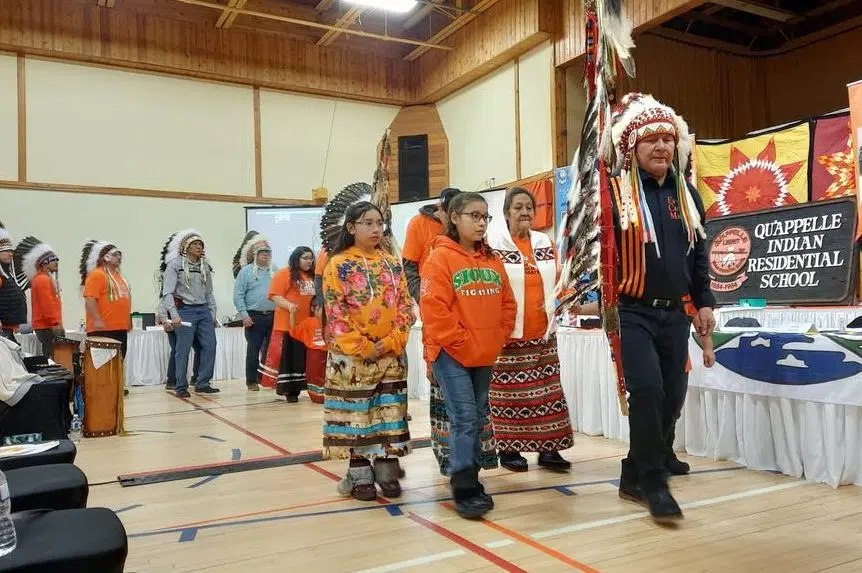Sheldon Poitras took a few moments Thursday to prepare the audience inside the Wah-Pii-Moostoosis gym for what he was about to say.
“I want to acknowledge everyone because we’re in this together,” Poitras told the hushed crowd inside the facility in Lebret, about 80 kilometres northeast of Regina. “This site housed a lot of survivors throughout the years.
“Lots of students from all over the country and even some States folks came up and attended school here, so this information is going to hit home. I’m not going to lie.”
Poitras is the director of operations for the Star Blanket Cree Nation’s ground search project team, which is using ground-penetrating radar to search for unmarked graves at the former site of the Qu’Appelle Indian Residential School.
He told those in attendance Thursday that the first phase of the search got more than 2,000 confirmed hits.
“Does that means there’s 2,000 unmarked graves? We don’t think so,” Poitras, who’s also a former student of the school, said during the media conference.
Poitras said the anomalies found during the search could be rocks, wood or other materials, so the search team plans to conduct core drilling into the anomalies to see if DNA can be extracted.
A fragment of a jawbone was found on the grounds of the old school in early October, Poitras said. He noted forensic examination of the jawbone determined it was about 125 years old and belonged to a child between the ages of four and six.
“This is physical evidence, physical proof, of an unmarked grave,” Poitras said.
The First Nation said it would honour the child’s remains and provide a proper burial to aid in the healing process.
“We don’t want anything … We want to honour the remains of this young child,” Chief Michael Starr said.
The Star Blanket Cree Nation announced in November of 2021 that it was starting the search for unmarked graves at the site using ground-penetrating radar. The search, which is being conducted by AXIOM Exploration Group, will cover more than 55 acres once it’s complete.
“Our hearts are heavy today. This has been a very emotional journey for all of us on the team (and) our community,” Starr said.
“I acknowledge that this is not our fault what we’re doing here. We acknowledge that. We are just doing the necessary work (on) what was brought here and what was given to us in terms of the land.”
Poitras said the project will test nearby bodies of water and will try to examine underground rooms that have been found by the radar to determine if human remains are present.
According to the National Centre for Truth and Reconciliation, the school — which was known at various times by Qu’Appelle, St. Paul’s and Whitecalf — was built in 1884. It was expanded in 1887, 1889 and 1895.
The original building burned down in 1903. Its replacement burned down in 1932, and a third facility was built in 1935. The school was torn down when it closed in 1998.
The residential school was operated by the Catholic Church until 1973, when it was taken over by the Qu’Appelle Indian Residential School Council. In 1983, the Star Blanket Cree Nation took over responsibility for the land and the school and, Starr said, tried to make things better for the students.
“It was unthinkable, it was profound, it was sad, it was hurtful and it made us very angry what happened to our young people here prior to 1973,” he said.
Many residential school survivors were in attendance at the gym, which was filled with people wearing orange “Every Child Matters” shirts.
One of those in attendance was Sharon Strongarm, who spoke emotionally while surrounded by friends and family who offered emotional support through her speech.
“We were taken away from our parents, but we learned how to survive. (Those who ran the school) tried to take our spirits away. They tried to take the Indian out of us,” said Strongarm.
“This country was literally built on the bones of our people,” added Federation of Sovereign Indigenous Nations Chief Bobby Cameron, who also was in attendance.
Minister of Crown-Indigenous Relations Marc Miller attended the conference via Zoom and offered his support on behalf of the federal government.
Similar searches in Saskatchewan on the Cowessess First Nation, the George Gordon First Nation and the Keeseekoose First Nation resulted in the discovery of a number of unmarked graves.
The searches in this province started after the discovery in May of 2021 of the remains of 215 children buried on the grounds of a former residential school in Kamloops.
— With files from 980 CJME’s Lisa Schick











